Conducting an Annual Review
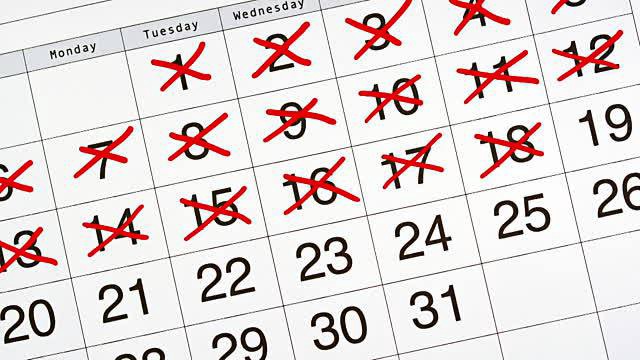
I posted this article last year on a different blog. It’s still pretty useful and worth sharing here for those of you interested in doing an annual review or learning about the process I follow. Some things have adapted or changed for me in the past year but this is still generally what I am following.
Since taking Tiago Forte’s exceptional course on personal knowledge management, Building a Second Brain, this past summer, I have not only seen and put into practice the morning, weekly and monthly reviews, I have tried to use them to build new habits into my life.
Daily, Weekly, Monthly Reviews
Besides learning and putting into practice things such as, Progressive Summarization, P.A.R.A. and “Just in Time Project Management,” that are core to Tiago’s Personal Knowledge Management’s curriculum, the practice of “reviewing” my work, specifically the morning review , where I put into practices the principles noted in Forte’s Zero Inbox Post, has had a greater impact on my work life more than anything else I’ve done, maybe ever.
Here is an example of my Morning Review, based largely off of Tiago’s system with a few tweaks of my own.
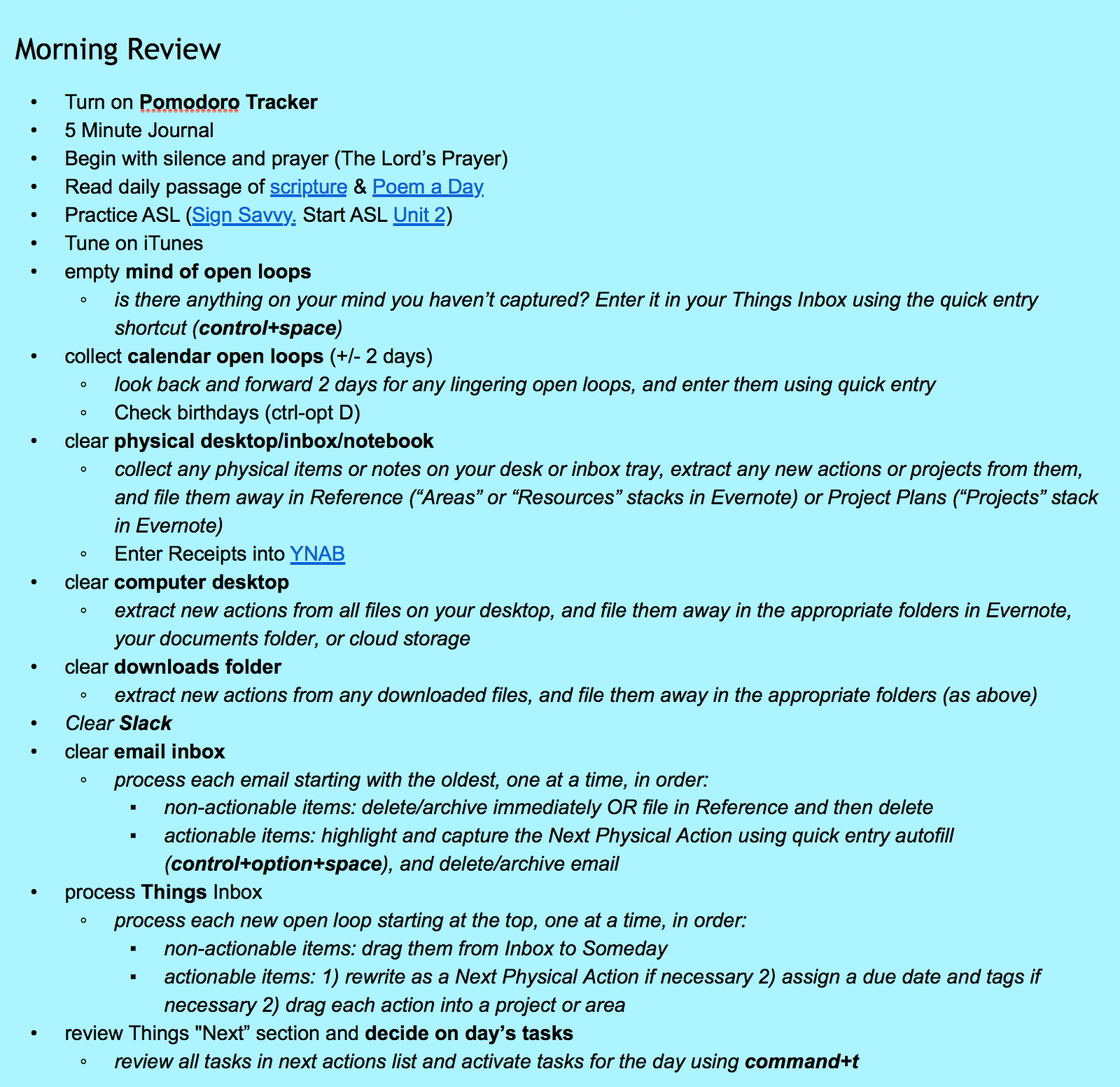
I take Tiago’s advice and use the sticky app on my mac. I like it because I don’t use stickies for anything but my different reviews. When I wake up in the morning all I need to remember to do is open stickies, and then I just go step by step. This works well for me because when I wake up in the morning I need as low a threshold as possible to help me get started. “Open Stickies” and “Go step by step through the list” is a pretty low threshold.
I have found that not only is a morning review good for staying on top of my work, it also helps with building mindfulness around my day. The first five points are really focused on building habits into my life that I want to be practicing daily.
Yearly Review
This was my first time doing an annual review after really designing a system of project management like we did in Building a Second Brain. I wasn’t quite sure what to do, and I did it before reading “The Annual Review is a Rearchitecture,” but I knew I wanted three components:
- Enough time away to get into a reflective and prayerful space
- Time to reflect back over all the projects, accomplishments, failures, learnings that took place.
- Time to build out my goals and vision for the coming year
I found a retreat space that offers day retreats for $25 a day and signed myself up for a day after the semester was over. When we still lived in Washington State, I enjoyed taking advantage of living close enough to the coast to going out there for a few days for these kinds of annual reflections. Just find a place where you can rest, let down the normal flow of stuff enough that you can be in a posture of listening.
Then I created an agenda for the day:
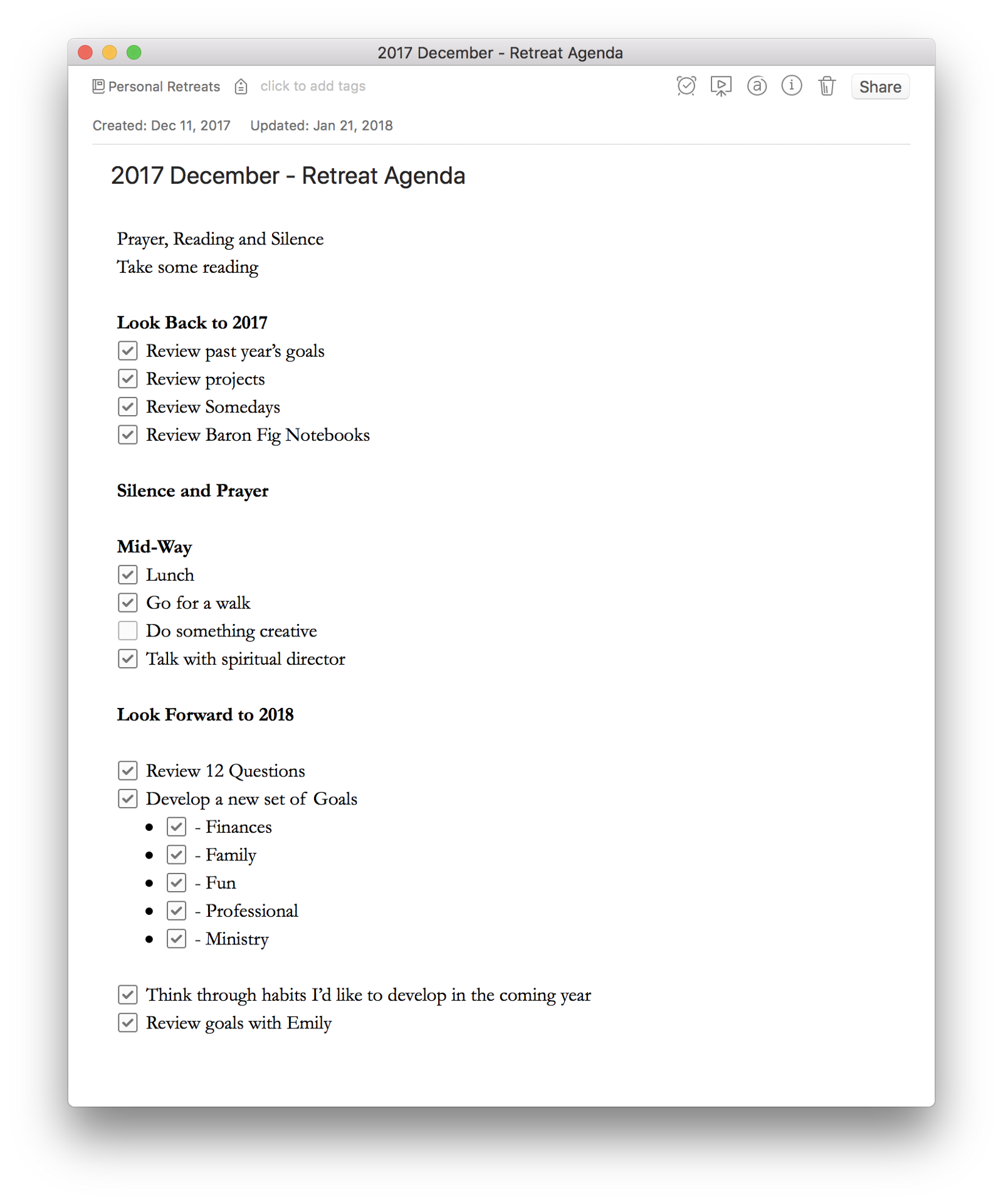
As you can see from my agenda, I built in the three pieces that were most important to me: reflection, looking back, and looking forward. I recommend Tiago’s Evernote template for Annual Review questions for a deeper dive that you can use to work through these various aspects of the retreat.
1. Silence and Prayer
I like to begin with silence and prayer. You can find whatever helps you to open up into a learning and listening space inwardly. I took time to read a little from Scripture, some from a prayer book I have, and then I spent time sitting in silence. A practice that is central to my spiritual life as a Quaker. I see this as kind of “priming the pump” so to speak, helping to open me up to what might come. I ask for help and insight. I am on this annual review retreat because I want to grow. I want to get better. I want to learn from the mistakes as much as I learn from the accomplishments.
2. Looking Back
In the looking back stage of my retreat I literally reviewed everything I have that I use to keep track of my life over the past year. That means, I spent time looking through my:
- Calendar
- Baron Fig Notebooks (I use 2 or 3 a year a kind of bullet journal) — I have events in there, random meeting notes, ideas, and notes from conferences I attended, and talks I gave.
- Evernote stacks, specifically Archives (what projects or areas of responsibility have I archived this year, and my projects stacks). Using P.A.R.A. here makes this part of the process much easier.

- Instagram and Flickr accounts, looking at the people/events/things I took photos of.
- Me previous goals for the year
- Someday/Maybe list to see what I got to and what I left hanging
- Books Read
- Favorite Albums listened to
If you have performance evaluations from your supervisor, this would be the place to bring those in and review them as well.
During this period of work, I was collecting key projects, ideas, events, conferences that impacted me from the previous year in an Evernote file titled: 2017 — “Retreat Self-Assessment and Accomplishments.” I won’t link to this because it’s personal, but in it is a long list of things that I’m proud of from last year, things I got done, things I didn’t finish, pivotal moments, etc. all in a checklist format.
3. Reflections and Integration
After I did all that — it took me about an hour and a half or so, I went for a walk. I spent some, time in silence, reflecting back on the all that happened in the past year. I let it soak in. This time was meant for reflection and allowing all of this to integrate in a way that might be useful as I look forward.
After lunch I called my spiritual director who helped me talk through some of the challenges I faced last year, celebrated the wins with me, and helped me begin to turn the corner in thinking about the coming year.
4. Looking Forward
During this part of the retreat the goal was to turn my attention to the coming year and receive it with confidence and gratitude. To get there, I did four main things:
I reviewed my 12 most favorite “big” problems. This is an exercise we did in Building a Second Brain. These big problems or questions are open-ended, life long questions that motivate my learning and growth. At the bottom over everything, these are the core questions that really energize my research, leadership, writing, teaching and more.
Here’s how Tiago describes these kinds of problems and questions:
They are probably hard problems without simple answers. The answers are probably very different depending on the person or situation. They are “high context” problems. Answering them would unleash huge value for yourself and others.
The purpose of this exercise is not only to clarify them for yourself, but to help you formulate and frame them in a way that makes it as easy as possible for others to help you.
I reviewed mine to see if these shifted for me? If I have new questions or need to adjust questions. And I wrote a couple new ones too.
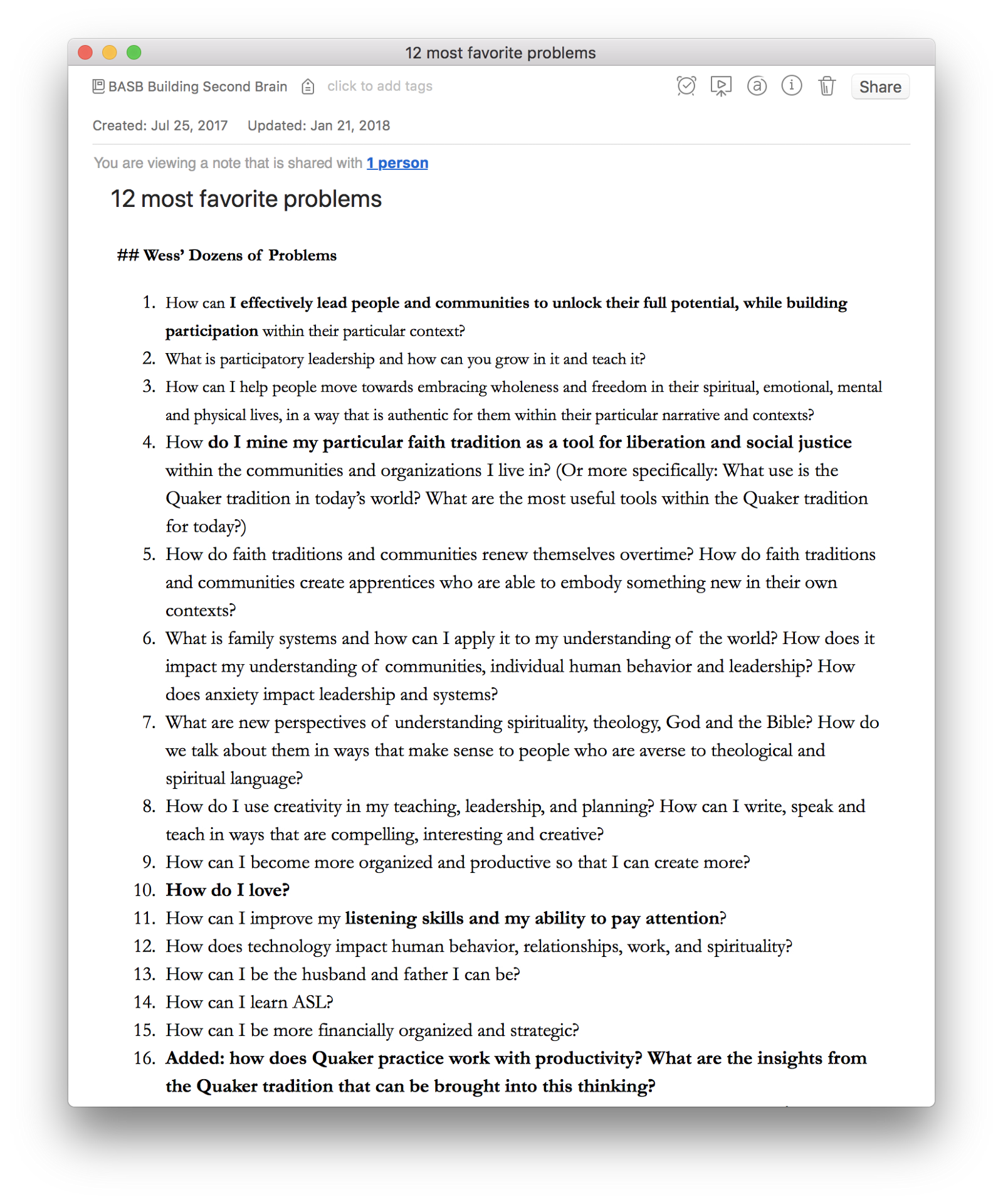
Next I developed a new set of goals and focused on all of the key areas of my life: finances, family, fun, professional, ministry and personal (as in physical, emotional health). In the past, I have focused my goals largely on professional, but this year I’ve expanded this list to include all the areas in my life where I want to see growth, change, etc.
As a side note, We use You Need a Budget website and methodology for our household budgeting and finances. I like to do a “Fresh Start” at the beginning of the year, so we can really examine all the areas of our budget and set new financial goals.
Review self-Care document: In 2017, I drew up some notes about things that help me relax, practice self-care, etc. I like having something to reference, especially when I’m feeling a bit frazzled. I reviewed that document and considered new habits and practices I’d like to work on in the coming year. One of them is to run more regularly.
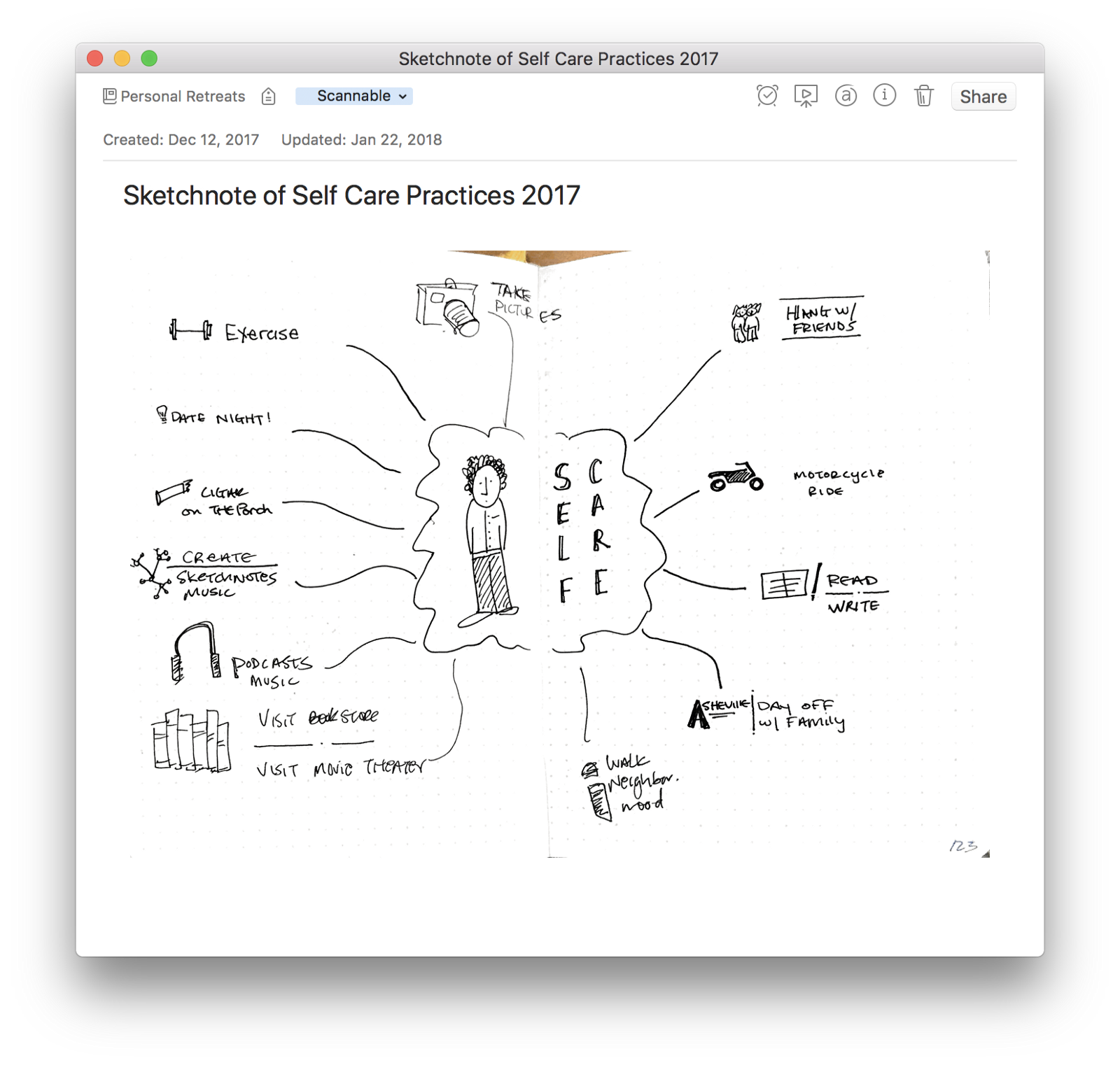
Check in with partner, friend, spiritual director, about your goals: Lastly, I sat down with my wife and shared what I worked on and goals I have for the coming year. This certainly helps with accountability but is also just good for communication and information sharing. We also took the time to set goals of our own together for the coming year. Including talk of a vacation!
Key Learnings:
Even in its simplicity, this process of annual review retreat was profound for me. It gave me perspective on the year that I needed and helped me re-frame my coming year in terms of gratitude and confidence, rather than the places where I was feeling tired or like I had failed. The act of looking back and reviewing the major goals, accomplishments, failures, lessons learned and events of the year allowed me to zoom out to the 10,000 feet perspective, enabling me to see that 2017 wasn’t any one week, month, or event. Had I not done this retreat, I know I would have fixated on the harder more challenging parts of the year. After my retreat, I was able to reflect on a whole year’s worth of work, learning, growth and challenge and see more wholly the work of the Spirit in my life in 2017. I hope you will make time to do the same and I’m interested in hearing what helps you at the end of the year prepare for what is to come.
Highly Recommended Annual Review Blog Posts:
How to Run Your Own Annual Review
Forget Resolutions—Here’s Your Blueprint for Making Next Year a Smash Hitbetterhumans.coach.meThe Annual Review is a Rearchitecture
I previously described how the weekly review is an operating system, funneling each bit of information you captured…praxis.fortelabs.co